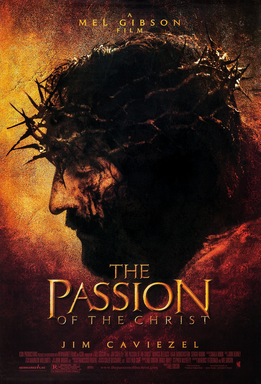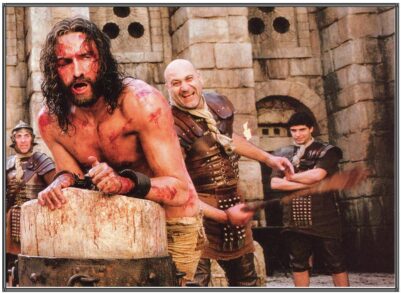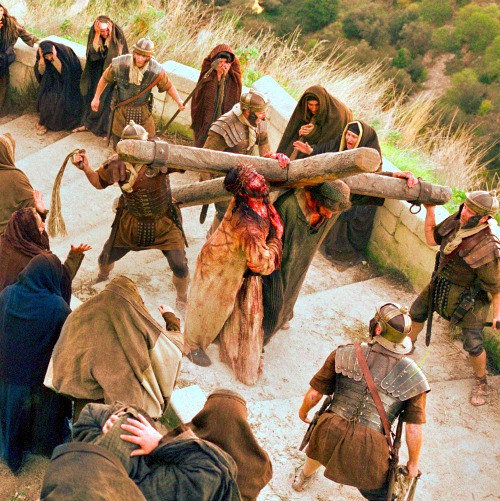 Does anyone remember Mel Gibson’s PASSION OF THE CHRIST? It’s not discussed much these days (I haven’t seen too many mentions of its two decade anniversary), but the film was quite the hot potato upon its February 25, 2004 release. Self-financed by Gibson and distributed by the late Newmarket Films, THE PASSION OF THE CHRIST was easily the most controversial American film release since Martin Scorsese’s LAST TEMPTATION OF CHRIST stirred things up 16 years earlier.
Does anyone remember Mel Gibson’s PASSION OF THE CHRIST? It’s not discussed much these days (I haven’t seen too many mentions of its two decade anniversary), but the film was quite the hot potato upon its February 25, 2004 release. Self-financed by Gibson and distributed by the late Newmarket Films, THE PASSION OF THE CHRIST was easily the most controversial American film release since Martin Scorsese’s LAST TEMPTATION OF CHRIST stirred things up 16 years earlier.
My initial feelings about Gibson’s film were nearly identical to my views on Scorsese’s: I found it wildly uneven and often downright boring, but with many diverting elements. Whereas LAST TEMPTATION was based on a Nikos Kazantzakis novel, PASSION is slanted more along the lines of Jim Bishop’s THE DAY CHRIST DIED. It purports to relate the final twelve or so hours of the life of Jesus Christ, during which he was tortured incessantly (or so Mel Gibson would have us believe) before being nailed up and rising from the dead. I initially respected the film’s focus and simplicity, and the fact that it removed the Passion from the sanitized realm of most Jesus movies, returning it to its gritty non-PC origins.
Twenty years on I find that my feelings about THE PASSION OF THE CHRIST haven’t necessarily changed, but they have grown more pronounced. The Garden of Gethsemane set opening, marked by blue filters and slow-motion violence, always seemed misconceived to me and is now borderline unwatchable, while the protracted mid-film trial sequence, in which governor Pilate (Hristo Naumov Shopov) is made out to be a nice fellow who doesn’t want to crucify Jesus (Jim Caviezel) but goes through with the execution due to pressure by his Jewish overlords, was extremely dull back then and seems even more plodding now. Furthermore, the frequent cutaways to the effeminate bald creep who’s supposed to represent Satan strike me as even sillier than they initially did, and I initially found them pretty damn silly.
Likewise, the characterizations always struck me as quite limited, but now seem downright regressive. There’s the impossibly perfect title character, whose does little except get knocked around, and the Marys (Monica Bellucci and Maia Morgenstern), who exist only to weep and wipe up blood. Gibson and co-screenwriter Benedict Fitzgerald evidently tried to compensate for their lack of behavioral nuance by having supporting players—specifically the guilt-wracked Judas (Luca Lionello), Pilate and the Judean everyman Simon of Cyrene (Jarreth Merz), who helps Christ with the cross—periodically take center stage, but none of those characters make much of an impression.
Of course the film’s major selling point was its bloodletting quotient, which by mainstream Hollywood standards was envelope-pushing. We see graphic scourgings (far more of them than the 39 lashes Jesus was supposedly dealt), flesh ripping, the crown of thorns hammered into its wearer’s skull, Jesus nearly crushed while carrying the cross and having his shoulder dislocated upon being stretched onto it, etc. This is literally the only movie I’ve ever seen where the theater manager warned the audience about its violent content—and that audience was quite an interesting bunch, weeping hysterically, speaking in tongues and shouting choice epithets at the screen such as (you guessed it) “Jesus Christ!”
If such graphic gore were presented in any other context it would likely be dismissed as exploitive and pornographic, but just as Cecil B. DeMille did years earlier (with THE KING OF KINGS and THE SIGN OF THE CROSS), Gibson got a free pass from religious leaders and the ratings board. Obviously the MPAA’s policies regarding onscreen torture (filmmakers seeking an R rating were traditionally required by the board to “cut repeated strikes with weapons, especially those accompanied by expressions of pleasure”) and the evangelical prohibition against viewing gore (according to a commentator on Reddit’s “Catholicism” thread, “Watching gore numbs you to the beauty of life. It creates a kind of preoccupation with death and misery that is not good”) were put on hold.
It was Gibson’s deft manipulation of audience reaction that was, I’d argue, his true accomplishment. Not only did he succeed in getting THE PASSION OF THE CHRIST an R rating, but he also successfully lobbied the religious right (not an easy group to court, as Paramount found out ten years later when it attempted to sell them on Darren Aronofsky’s NOAH). They responded quite favorably, mobilizing church groups and right wing media to promote the film (in the early months of ‘04 FOX News was essentially “all Mel all the time”), which went on to become the highest-grossing independent release of all time.
In the opposing camp were Biblical literalists (the film didn’t follow the gospels nearly as closely as Gibson liked to claim it did) and Jewish groups, who took umbrage with THE PASSION OF THE CHRIST from the screenplay stage onward. Typical was a quote by Jewish biblical scholar Géza Vermes, who dismissed the film as “horribly gory, historically wrong—and it will inspire judeophobia.”
It was a Jewish protest staged outside the NYC Fox News Building that caused the film’s initial distributor 20th Century Fox to drop it (although they changed their minds when PASSION made it to DVD). Such protests, alas, only fueled the film’s supporters; as the mission statement of the late SupportMelGibson.com proclaimed, “In the current controversy, Mel Gibson is David against the Goliath of the anti-Christian Hollywood establishment and politically powerful Jewish leaders.”
Yet beyond providing a lightning-rod for right wingers, THE PASSION OF THE CHRIST can be said to have transformed the very nature of Christianity. As author Neal King stated in his 2011 book on the film, “Whatever it ought or will be decades hence, Christianity is a blood cult now, dwelling on the cross as a means of execution.” Bloodletting, in other words, is now part and parcel to the religion due to THE PASSION OF THE CHRIST.
Ultimately, though, the film appears to have been a one-off, a product of a very specific time and place (the US in the wake of 9/11) whose success is never to be repeated. Witness THE PASSION RECUT, a toned-down version distributed in 2005 that amassed a measly half-a-million dollar gross. That same year saw the release of UNCLE NINO, a sentimental family drama with Joe Mantegna and Anne Archer that replaced THE PASSION OF THE CHRIST as the major conservative cause celebre, while 2023’s SOUND OF FREEDOM, executive produced by Mel Gibson, appears to have completely erased all memory of this now twenty year old shock fest from the minds of its target audience. That’s probably for the best.


